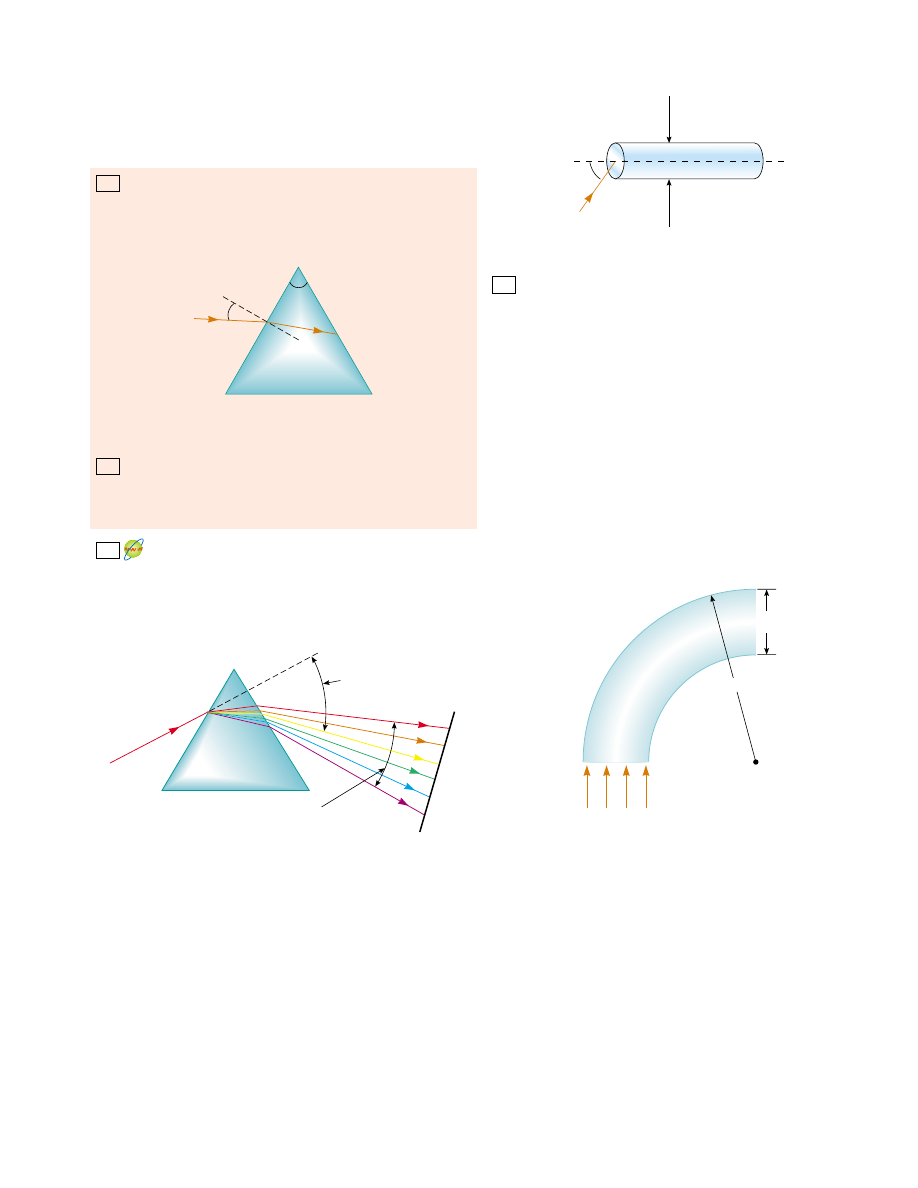Physics For Scientists And Engineers 6E - part 281

Problems
1121
Consider a common mirage formed by super-heated air
just above a roadway. A truck driver whose eyes are 2.00 m
above the road, where n ! 1.000 3, looks forward. She
perceives the illusion of a patch of water ahead on the
road, where her line of sight makes an angle of 1.20°
below the horizontal. Find the index of refraction of the
air just above the road surface. (Suggestion: Treat this as a
problem in total internal reflection.)
40.
An optical fiber has index of refraction n and diameter d.
It is surrounded by air. Light is sent into the fiber along its
axis, as shown in Figure P35.40. (a) Find the smallest
outside radius R permitted for a bend in the fiber if no
light is to escape. (b) What If? Does the result for part
(a) predict reasonable behavior as d approaches zero? As
n increases? As n approaches 1? (c) Evaluate R assuming
the fiber diameter is 100 2m and its index of refraction
is 1.40.
39.
41.
A large Lucite cube (n ! 1.59) has a small air bubble
(a defect in the casting process) below one surface. When
a penny (diameter 1.90 cm) is placed directly over the
bubble on the outside of the cube, the bubble cannot be
seen by looking down into the cube at any angle. However,
when a dime (diameter 1.75 cm) is placed directly over it,
the bubble can be seen by looking down into the cube.
What is the range of the possible depths of the air bubble
beneath the surface?
42.
A room contains air in which the speed of sound is
343 m/s. The walls of the room are made of concrete, in
which the speed of sound is 1 850 m/s. (a) Find the
critical angle for total internal reflection of sound at
the concrete–air boundary. (b) In which medium must the
sound be traveling in order to undergo total internal
Figure P35.35
Figure P35.38
Figure P35.40
Visible light
Measure of
dispersion
Deviation of
yellow light
Screen
R
O
Y
G
B
V
θ
µ
2.00 m
R
d
Figure 35.25. (b) Find the angle of deviation 3
min
for
&
1
!
48.6°. (c) What If? Find the angle of deviation if the
angle of incidence on the first surface is 45.6°. (d) Find
the angle of deviation if &
1
!
51.6°.
A triangular glass prism with apex angle 4 ! 60.0° has an
index of refraction n ! 1.50 (Fig. P35.33). What is the
smallest angle of incidence &
1
for which a light ray can
emerge from the other side?
33.
Figure P35.33 Problems 33 and 34.
Φ
1
θ
A triangular glass prism with apex angle 4 has index of
refraction n. (See Fig. P35.33.) What is the smallest angle
of incidence &
1
for which a light ray can emerge from the
other side?
The index of refraction for violet light in silica flint
glass is 1.66, and that for red light is 1.62. What is the
angular dispersion of visible light passing through a prism
of apex angle 60.0° if the angle of incidence is 50.0°? (See
Fig. P35.35.)
35.
34.
Section 35.8 Total Internal Reflection
36. For 589-nm light, calculate the critical angle for the follow-
ing materials surrounded by air: (a) diamond, (b) flint
glass, and (c) ice.
37. Repeat Problem 36 when the materials are surrounded by
water.
38.
Determine the maximum angle & for which the light rays
incident on the end of the pipe in Figure P35.38 are
subject to total internal reflection along the walls of the
pipe. Assume that the pipe has an index of refraction of
1.36 and the outside medium is air.